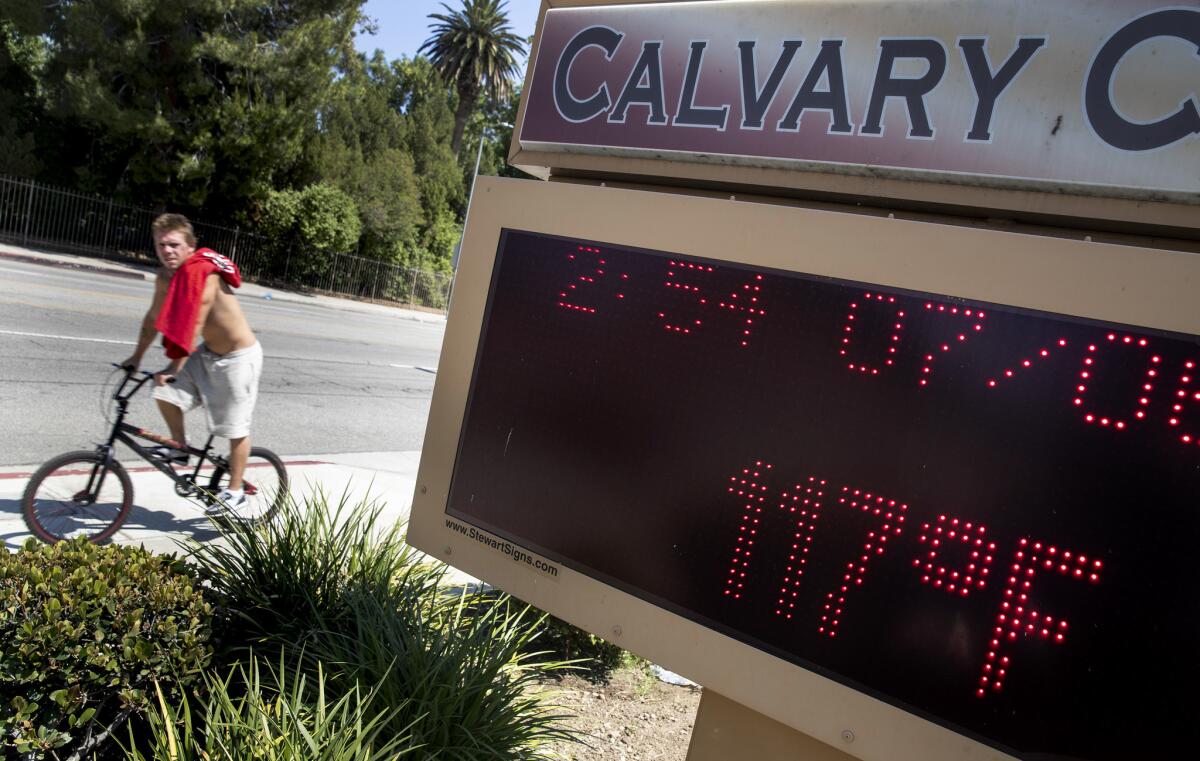2018 was one of the hottest years on record — and this year could be even hotter

All five of the hottest years on record have occurred in the last five years, according to global temperature data released Wednesday by NASA and the National Oceanic and Atmospheric Administration.
While 2018 was slightly cooler than the three prior years, Earth still had its fourth-warmest year since scientists began keeping records in 1880, the federal agencies said. Their separate analyses add to decades of evidence that the burning of fossil fuels, the clearing of forests and other human activities are releasing heat-trapping greenhouse gases into the atmosphere and causing the planet to warm.
“If you smooth out these year-to-year variations and look at the big picture, the overall trend in the past few decades is one of accelerating change,” said Alex Hall, who directs the Center for Climate Science at UCLA and was not involved in either government analysis. “We are seeing more and more warming that is happening at a faster and faster rate.”
Last year’s average global surface temperature was 1.49 degrees Fahrenheit above a baseline period between 1951 and 1980, according to NASA.
The warmest year was 2016, followed by 2017, 2015, 2018 and 2014, according to NASA’s rankings.
All five of those years were exceptionally warm, with only slight differences that were driven by natural variations in the weather, including the alternating cool and warm cycles from El Niño and La Niña.
“You get ups and downs — years that are a little bit warmer, a little bit cooler — but the long-term underlying trend is very, very clear,” said NASA climatologist Gavin Schmidt, who worked on the space agency’s analysis. “It’s the long-term trends that are having impacts on ice, on severity of droughts, on heat waves, on sea level rise and wildfires.”
In a nod to those effects, NOAA’s report detailed 14 climate-related disasters across the U.S. last year with losses exceeding $1 billion. The $91 billion in collective losses from those disasters was the fourth-largest total in records dating back to 1980.
Most of the damage was from hurricanes Florence and Michael, which pummeled Southeastern states, and from Western wildfires, including the Camp fire that killed 86 people and destroyed more than 13,900 homes in the Sierra Nevada town of Paradise.
NOAA calculated the 2018 average global surface temperature was 1.42 degrees Fahrenheit above the average for the entire 20th century.
The combination of rising greenhouse gases and a mild El Niño underway in the Pacific Ocean means it’s likely that 2019 will be hotter than 2018. Scientists say there’s a very good chance this year will wind up ranking among the top five hottest on record, barring an abrupt planet-cooling event such as a giant volcanic eruption.
NOAA and NASA each analyze temperature measurements from thousands of sites around the world, including weather stations on land and ships and buoys spread across the world’s oceans.
The two agencies use much of the same data but perform independent analyses with minor differences in methods that yield slightly different rankings. NASA, for instance, ranked 2015 as the third-warmest year on record, while NOAA said it was 2017. But the two agencies strongly agree on the long-term pace and trajectory of global warming.
Temperatures in 2018 were higher than average across much of the globe, including most of the continental United States, federal scientists said. The Arctic region is warming two to three times faster than the global average, and those higher temperatures continue to drive the decline in sea ice there. The average annual sea ice extent was 4 million square miles in 2018, the second-smallest figure in records going back to 1979, NOAA reported.
Those observations are at odds with President Trump’s statements attacking the scientific consensus on climate change. Icy cold weather across the Midwest and Eastern U.S. last week prompted Trump to tweet a plea to global warming: “Please come back fast, we need you!”
Scientists say such remarks confuse short-term natural variations — that is, weather — with long-term shifts in the climate that are driven by human activity. Indeed, that natural variation is why climate scientists look primarily at temperature trends over long timescales and don’t give too much significance to a single hot or cold year.
Global warming is also increasingly evident in local measurements, where daily records for high temperatures are toppling more than twice as often as daily records for low temperatures, said Gerald Meehl, a senior scientist at the National Center for Atmospheric Research.
“If there was no warming of average temperatures, there would be about an even chance of a daily record high maximum or daily record low minimum occurring,” said Meehl, who was not involved in the report.

Much of the warming across the U.S. is being driven by higher nighttime and morning temperatures. NOAA’s analysis found minimum overnight temperatures rising more than afternoon maximum temperatures, in keeping with trends observed so far this century.
Generally speaking, “the cold times of year are not reaching the depths of cold that they used to, the cold times of day are not reaching the depths of cold that they used to, and the colder places are not reaching the depths they used to,” said Derek Arndt, monitoring chief for NOAA’s National Centers for Environmental Information.
The NASA and NOAA reports are consistent with other analyses. On Wednesday, the United Nations’ World Meteorological Organization and Britain’s Met Office also said that 2018 was among the top four warmest years. The Japan Meteorological Agency and the European Union’s Copernicus Climate Change Service already published reports concluding that 2018 was the fourth-warmest year on record.
An independent analysis released last month by Berkeley Earth calculated that in 2018, 85% of the Earth’s surface was significantly warmer than the planet’s average temperature from 1951 to 1980. Meanwhile, only 2.4% of the surface was significantly colder than that baseline period.
Last year, 29 countries — including much of Europe and the Middle East — and the continent of Antarctica had their hottest years on record, said Zeke Hausfather, a climate scientist with the nonprofit research organization.
Yet Trump has dismissed the threat of climate change, including a landmark assessment by 13 federal agencies last fall that found climate change is inflicting increasing damage to the nation’s environment, health and economy.
“I don’t believe it,” Trump said at the time without offering any evidence to counter the conclusions of hundreds of the nation’s leading climate scientists.
The November report warned that climate change will intensify over the century without swift emissions cuts. Instead, his administration is working to unravel Obama-era environmental rules in favor of policies that would allow more greenhouse gas emissions from cars, trucks and coal-fired power plants.
The 2018 global temperature reports were originally scheduled for release in mid-January, but they were delayed because the 35-day partial government shutdown prevented government scientists from finalizing their calculations.
Trump has vowed to pull out of the 2015 Paris agreement forged by nearly 200 countries, including the U.S. The pact sets a goal of keeping global warming “well below” 3.6 degrees Fahrenheit over pre-industrial levels, a threshold intended to avert the most devastating and irreversible effects of climate change.
Despite international efforts, planet-warming emissions are trending upward.
After a three-year plateau, global carbon emissions increased 1.6% between 2016 and 2017, then jumped an additional 2.7% in 2018, according to estimates published last month by scientists at Stanford University and other research institutions. One reason, they said, is a persistent appetite for oil — including unexpected growth in the United States and Europe, where experts thought its use had already peaked.
Twitter: @tonybarboza







